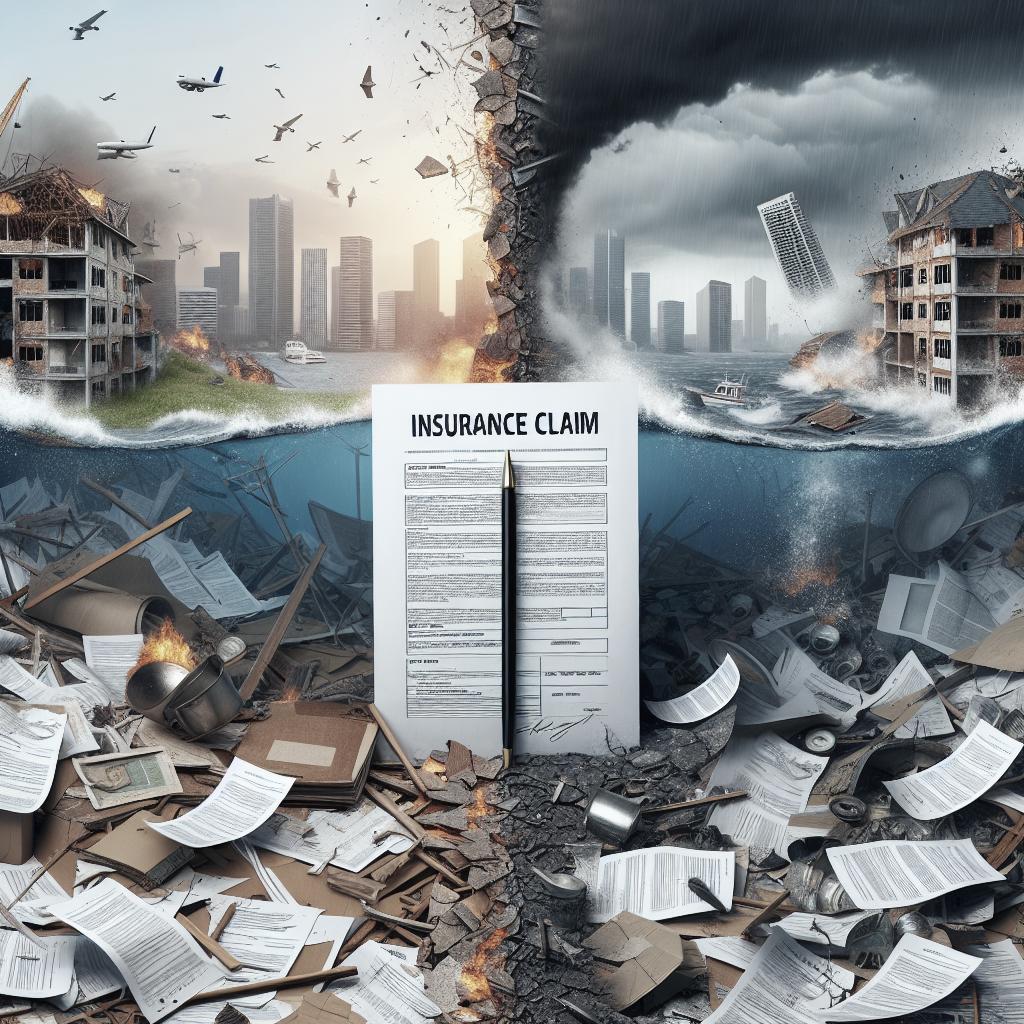“`html
Impact of Natural Disasters on Insurance Claims
Natural disasters have become a more frequent and severe occurrence, with profound effects on various sectors of society, including the insurance industry. As hurricanes, wildfires, floods, and other calamities occur with increasing intensity, they bring about significant repercussions in insurance claims processing, policy adjustments, and premium rates. This blog post delves into the multifaceted impact that natural disasters have on insurance claims, exploring billion-dollar disaster costs, fluctuations in home insurance premiums, coverage specifics, and more. We will also highlight changes in policy and rating adjustments in response to these environmental crises, identify high-risk areas, and present data-driven insights into the financial ramifications faced by the most vulnerable states. The post dives into frequently asked questions about insurance in the context of natural disasters and concludes with actionable steps for policyholders to manage their risk effectively.
Billion-dollar disasters
In the past decade, the world has seen an increasing number of billion-dollar natural disasters. These events are not only significant due to the damage they inflict on communities and economies, but also because they push the insurance industry into recalibrating strategies on a monumental scale. The financial burden on insurance providers rises, often necessitating changes in premium rates and claim handling approaches.
Insurers are encountering unprecedented challenges, from soaring claim volumes to complex assessments of damage. Emerging technologies like AI and machine learning are becoming pivotal in managing claims quickly and accurately. These tools assist in efficiently quantifying damage and predicting future risks, aiding insurers in crafting policies that balance affordability with adequate coverage.
Droughts: The forgotten natural disaster
Often overshadowed by more immediate catastrophes like hurricanes and earthquakes, droughts represent a silent but equally impactful natural disaster on insurance claims. Droughts can devastate agricultural output, strain water resources, and trigger indirect effects such as fires, further complicating insurance claims.
For insurance companies, the slow onset and prolonged duration of droughts pose unique challenges. Policies may need to encompass losses not only from immediate effects on agriculture but also on related industries and communities. Addressing these challenges requires innovative coverage solutions that consider long-term environmental changes and potential escalations in risk.
2024 Natural disaster-related data and statistics
The data and statistics from 2024 reflect an alarming increase in both the frequency and intensity of natural disasters. According to recent reports, overall economic losses due to natural disasters surpassed previous records, emphasizing the pressing need for strategic adaptation by insurance companies.
Insurance claims stemming from these events are on the rise, with a growing number of policyholders seeking coverage for unprecedented damages. This trend underscores the necessity for insurers to assess risk more accurately and update their tools and models to predict and manage these events effectively. The numbers from 2024 signal a pivotal moment for the industry, one where proactive risk management and innovative policy solutions are imperative.
How natural disasters impact your home insurance rate
Price surge: Catastrophic disasters drive up rebuilding costs
Natural disasters can lead to a dramatic surge in home insurance premiums. The cost needed to repair or rebuild properties rises sharply after such events, driven by demand for construction materials and labor. This, coupled with supply chain disruptions, further inflates costs, impacting insurance rates directly.
Insurers must adjust their pricing models to account for these factors, often leading to increased premiums for consumers. Policyholders in high-risk areas witness the steepest hikes, a reflection of insurers’ strategies to balance risk with financial feasibility. This adjustment ensures companies can cover future claims while maintaining business solvency.
How to insure excluded natural disasters
Many standard insurance policies exclude certain natural disasters, leaving homeowners at risk. For instance, flood and earthquake insurance often require separate policies or riders, adding complexity and additional costs for consumers seeking comprehensive coverage.
To mitigate this, homeowners should consult with their insurance providers to understand their current coverage and explore additional options for these excluded events. Tailored riders or specialized policies, focusing on gaps, can ensure that properties remain protected against a comprehensive spectrum of potential natural disasters.
Does homeowners insurance cover natural disasters?
Homeowners insurance policies typically cover a range of risks, yet natural disasters present a more complex scenario. Standard policies often include coverage for events like hurricanes, tornados, and hail, but they might exclude incidents such as floods or earthquakes due to their specific, high-risk nature.
To navigate these limitations, policyholders need to carefully review their insurance documents and consult agents for clarifications. Understanding the scope and limits of coverage is crucial for adequately protecting property and financial assets against unforeseen and catastrophic events.
Drastic rating and policy changes in response to extreme weather
Smart risk management strategies
In response to increased extreme weather, insurers are adopting advanced risk management strategies. These include leveraging cutting-edge predictive analytics and climate modeling to reassess traditional risk profiles and develop proactive coverage solutions.
By incorporating real-time data and historical trends, insurers can offer more robust policies that reflect the evolving risk landscape. Additionally, insurers emphasize the value of promoting preventative measures to policyholders, such as home fortification tips and disaster preparedness, minimizing potential damage before it occurs.
Highest-risk areas for natural disasters
Some regions face a higher propensity for natural disasters due to geographical and climatic conditions. Coastal areas, for instance, are more susceptible to hurricanes, while states in the western U.S. frequently experience wildfires and droughts.
Insurers closely monitor these risk factors to tailor their offerings accordingly. Policies in these high-risk areas often come with increased premiums and specific endorsements to manage potential losses effectively. It highlights the critical need for dynamic policy adjustments in response to environmental shifts.
Three factors driving the market correction
The insurance market is experiencing a correction driven by three predominant factors: climate change, technological advancements, and regulatory pressures. Climate change enhances the frequency and severity of natural disasters, necessitating an urgent recalibration of premiums and coverage terms.
Meanwhile, technology enables insurers to enhance risk assessment accuracy, and regulatory frameworks are evolving to ensure consumer protection and corporate responsibility in light of these challenges. Together, these factors are steering the market towards a more sophisticated and resilient future.
States that are most impacted by flood costs
Flooding remains one of the costliest natural disasters in the United States, heavily impacting states with significant floodplain areas. Louisiana, Florida, and Texas often bear the brunt of flood-related costs, which influence statewide insurance premiums and coverage solutions.
To manage these costs, states are investing in infrastructure improvements and community resilience programs aimed at mitigating flood risks. Simultaneously, insurance providers work to develop more precise flood models that better assess risk, helping to stabilize insurance markets despite ever-present natural threats.
States that are most impacted by wildfire damage costs
States such as California, Washington, and Oregon have seen a surge in wildfire-related damages, posing significant challenges for homeowners and insurers alike. Wildfires devastate vast areas, leading to skyrocketing insurance claims and a re-evaluation of coverage availability in fire-prone zones.
As these fires grow in frequency and intensity, insurers need to employ more nuanced risk models and consider incentivizing homeowners for undertaking fire-mitigation measures. Strategies such as defensible space, fire-resistant materials, and community fire management plans can help reduce costs while securing properties.
Frequently asked questions
What are the most common natural disasters?
The most common natural disasters include floods, hurricanes, wildfires, tornadoes, and earthquakes. Each possesses unique characteristics and impacts, requiring particular insurance covers and considerations for effective risk management.
What state experiences the fewest natural disasters?
States like Michigan and Minnesota frequently rank as having relatively fewer natural disasters. Their geographic location shields them from hurricanes, and while they experience some weather events, these are often less impactful compared to other regions.
Which state pays the most for home insurance?
States such as Florida typically pay the highest for home insurance. This is largely due to their exposure to frequent hurricanes, leading to an increased risk profile and higher premiums set by insurers to accommodate potential claims.
What was the most expensive natural disaster?
Hurricane Katrina, which struck in 2005, is among the most expensive natural disasters in U.S. history. It resulted in over $125 billion in damages, causing insurers to reassess coverage strategies for future hurricanes and related disasters.
In which states is it the hardest to find home insurance?
Securing home insurance can be particularly challenging in states prone to high-risk weather events, such as California for wildfires and coastal areas in the Southeast for hurricanes. Insurers often apply stringent criteria and increased premiums in these regions, reflecting the heightened risk levels.
Methodology
This blog post was informed by extensive research across a variety of authoritative sources, including industry reports, insurance company publications, and government data on climate-related losses. By synthesizing this information, we aimed to provide an up-to-date and comprehensive overview of the impact of natural disasters on insurance claims.
Next steps
| Section | Key Insights |
|---|---|
| Billion-dollar disasters | Increasing frequency and cost; insurers adapting with technology |
| Droughts | Droughts impact agriculture and insurance claims, requiring innovative coverage |
| 2024 Data | Record-breaking losses stressing insurance models |
| Home insurance rates | Rising costs due to material/labor demand post-disaster |
| Excluded disasters | Need for additional policies/riders for comprehensive coverage |
| Coverage specifics | Understanding policy limitations essential for preparedness |
| Rating and policy changes | Adoption of predictive analytics for better risk management |
| High-risk areas | Key states with significant exposure require premium adjustments |
| Flood and wildfire impacts | Specific states face unique challenges and high costs |
| FAQs | Tackles common inquiries on insurance in disaster-prone states |
“`


